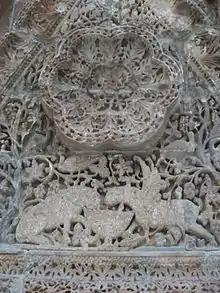Mshatta Facade
The Mshatta Facade is the decorated part of the facade of the 8th-century Umayyad residential palace of Qasr Mshatta, one of the Desert Castles of Jordan, which is now installed in the south wing of the Pergamon Museum in Berlin, Germany. It is part of the permanent exhibition of the Pergamon Museum of Islamic Art dedicated to Islamic art from the 8th to the 19th centuries. This was only a relatively small section of the full length of the facade, surrounding the main entrance; most of the wall was undecorated and remains in situ.
.jpg.webp)
History

The facade belonged to the Qasr Mshatta or Mshatta palace, which was excavated about 30 km south of the contemporary Jordanian capital of Amman. It is thought to have served as a winter residence and storage halls during the Umayyad period. The building of the palace probably dates to the era of the caliph Al-Walid II (743-744). After Al Walid was murdered, it was left incomplete and later ruined in an earthquake. The sections of the outer wall remaining in situ are much plainer.
Unusually for an Umayyad building, the main structures are built from burnt bricks resting on a foundation layer of finely dressed stone; the carved facade is also in stone. The name of the place, Mshatta, is a name used by the modern Bedouins in the area, and the original name remains unknown.
The remains of the palace were excavated in 1840. The facade was a gift from the Ottoman Sultan Abdul Hamid II to Emperor Wilhelm II of Germany. A large part of it was brought to the then Kaiser-Friedrich-Museum (now the Bode Museum) in Berlin in 1903. It was reconstructed as a 33 metres long, 5 metres high facade, with two towers, and parts of a central gateway. In 1932 it was reconstructed in the Pergamon Museum. It was seriously damaged during the Second World War and the bombardment of Berlin. Today, it is one of the most important exhibits of the Museum für Islamische Kunst in the Pergamon Museum, and a key monument of early Islamic art and architecture, demonstrating early forms of the arabesque, millefleur and also animals carved in relief.
There has been much discussion of the fact that the decoration on the left side of the facade contains many animals among the foliar forms, while on the right of the entranceway in the centre there are no animals. It has been suggested that this is because the right-hand side was the outside wall of the mosque.[1]
Gallery
_(6349361315).jpg.webp) Drawing of the reconstruction by Bruno Schulz in 1903, presented in the Museum of Islamic Art in Berlin.
Drawing of the reconstruction by Bruno Schulz in 1903, presented in the Museum of Islamic Art in Berlin.
See also
References
- Richard Ettinghausen, Oleg Grabar and Marilyn Jenkins-Madina, 2001, Islamic Art and Architecture: 650-1250, 50, Yale University Press, ISBN 0-300-08869-8
- Grabar, Oleg The Date and Meaning of Mshatta Dumbarton Oaks Papers, Vol. 41, Studies on Art and Archeology in Honor of Ernst Kitzinger on His Seventy-Fifth Birthday (1987), pp. 243–247
- Enderlein, Volkmar Mshatta-A Caliphs Palace The Pergamon Museum Information leaflet No. ISL I, Berlin, 1996
External links
| Wikimedia Commons has media related to Mshatta facade. |